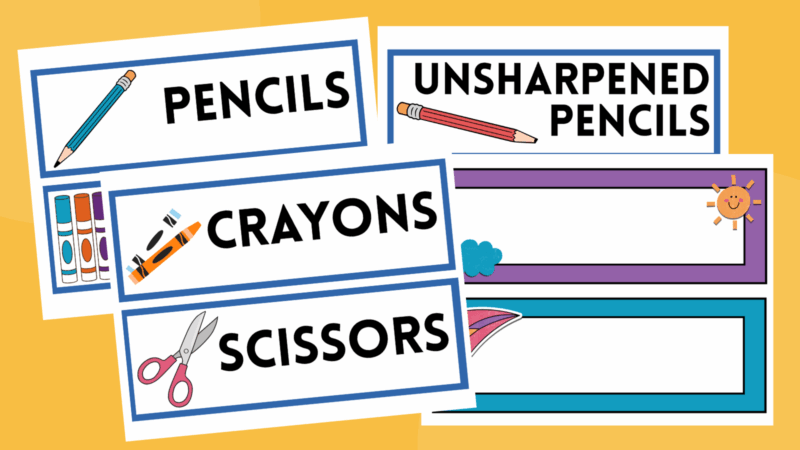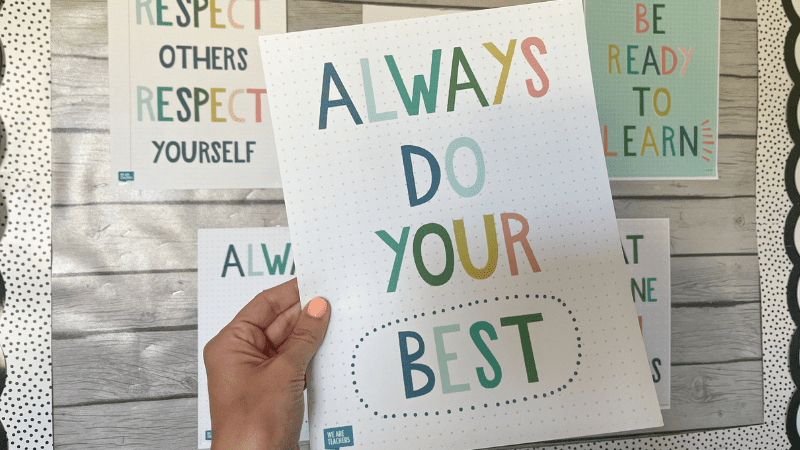Setting up a kindergarten classroom isn’t just about bulletin boards and cute themes. It’s about designing a learning environment that helps students feel confident, know where things go, and stay engaged from the very first day. Whether you’re a new teacher or just looking for new classroom setup ideas, your physical space can completely shift how your students learn and interact. After trying a lot of different arrangements and decor over the years, I’ve found that the best classroom setup is one that gives younger students easy access to materials and spaces so they can build independence early on.
My style is simple: organize with intention and make your room work for you and your students. Here’s how I set up my kindergarten classroom from the beginning of the school year to make the most of our learning space.
Sketch out your classroom layout
I list all my furniture before I even think about decorating or printing labels. Then, I sketch out my classroom on a blank piece of paper. I draw in windows, bulletin boards, doors, counters—anything that can’t move. Then, I start drawing out my furniture: my kidney table, student tables, classroom library, etc. This helps me figure out what fits where, how the flow of the room will work, and which areas might need to shift. Doing this early in the summer, or even before school ends, gives you a clearer picture of your classroom space without constantly moving heavy furniture around.
If you’re still gathering materials, this ultimate checklist of kindergarten classroom supplies can help you think through what you’ll need before your setup even begins.
Choose your wall decor carefully
I also think about what I want on the walls. I make sure I don’t place furniture in front of bulletin boards or wall spaces that we will frequently be using. This helps me remember where I can place lower furniture or smaller student seating. For instance, I don’t want to cover my calendar area with anything too large in case I decide that I want my students to point to something on the calendar.
Test every student seating area
Before I hang a single thing, I plan the classroom layout. I sit at every table, move around pillows, and lounge on the rug to make sure I can see the whole room from my small group table. If I can’t, I move things around. My goal is to ensure that small group work can happen without distractions and that every part of the room is functional.
Set up your whole group teaching area
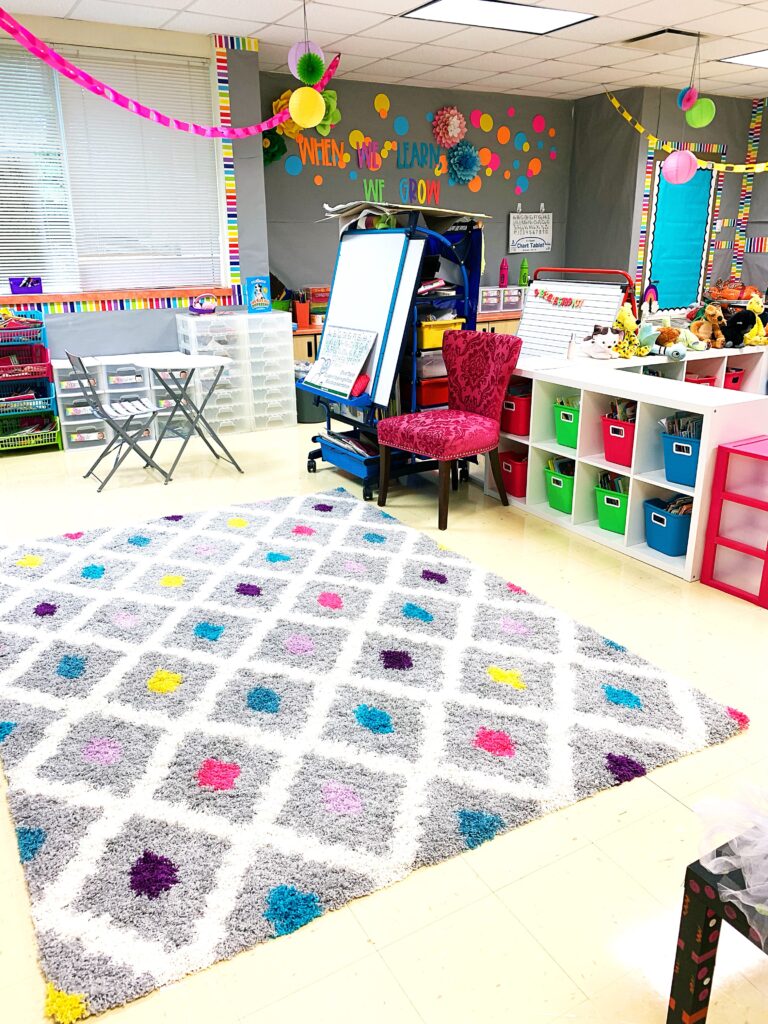
My main teaching area is centered around our Smartboard, with the whole group rug aligned right in front of it. My easel is just off to the side of the rug, where I hang chart paper and keep a few go-to supplies. Next to the easel is my pink chair, which anchors the teaching space and gives me a cozy spot for read-alouds. Right beside the rug is a slim table that holds my laptop and document camera. It connects to the Smartboard, which makes it easy to switch between whole group teaching and displaying something larger for the students to see.
Make sure your rug is big enough
When I choose a rug, I make sure there’s enough space for every student to sit without being elbow-to-elbow. That extra breathing room helps with classroom management during whole group lessons. If you’re refining your classroom expectations, these kindergarten classroom management ideas offer helpful strategies that can work with any setup.
Check out our favorite classroom rugs.
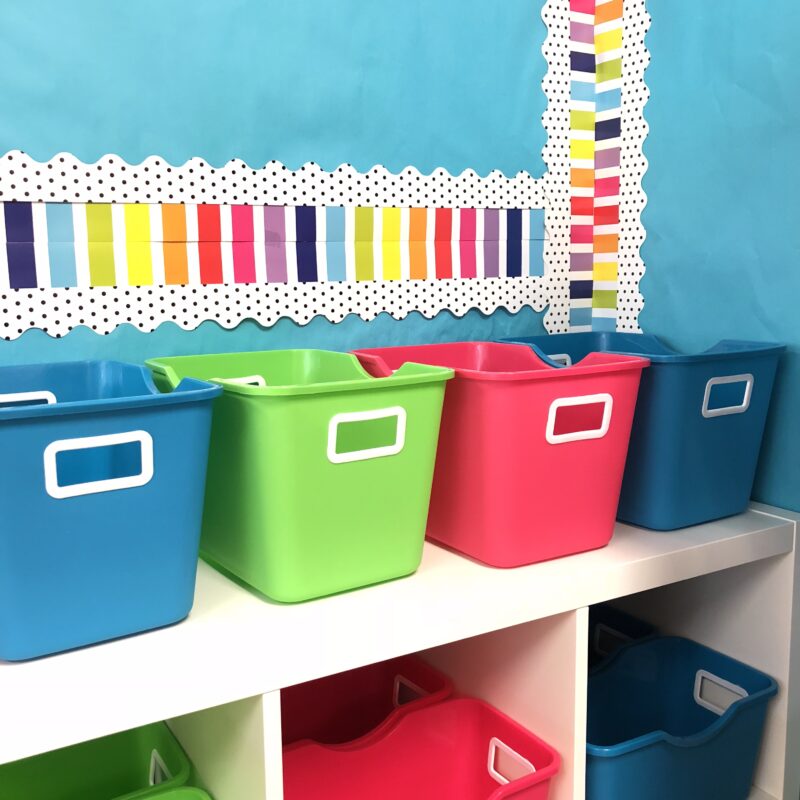
Independence is the most important thing I plan for in any kindergarten classroom. I want students to be able to move around the room, get what they need, and put it back without asking me every time. That starts with organizing everything at their level.
Give each student a personalized cubby, book bin, and mailbox
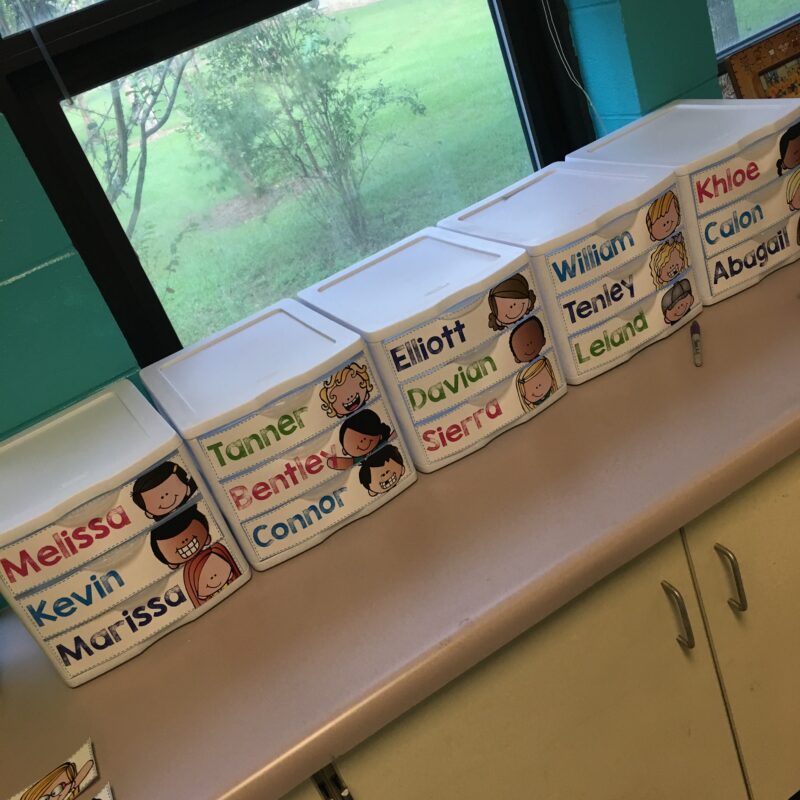
Each student has a labeled cubby, a book bin, and a mailbox—all with their name and a matching Melonheadz clipart version of themselves. Even if they can’t read yet, they can still identify their space. The mailboxes sit at the top of a counter, making checking for take-home work and notes easy. The cubby drawers are spread throughout the classroom to avoid traffic jams. When it’s time to grab something, I call students by number or by who has a top or bottom cubby. It’s one of my favorite ways to reduce chaos at transition times. If you’re short on furniture, laundry baskets under tables work perfectly for backpacks. I’ve also used open bookshelves for water bottles and lunch boxes.
Take a look at some of the best book bins for classrooms.
Label all classroom bins with words and pictures
I label every classroom bin with both a word and a picture: pencils, math tools, books, blocks, and so on. When something gets misplaced, they know exactly where it goes.
Position your small group table with the whole class in mind
My kidney table sits along the back wall of the classroom. I’ve placed it so that I can easily glance up and see the entire room without turning my head much. This spot helps me monitor students during centers or independent work while focusing on small group instruction.
Check out the best classroom tables for kids of all ages.
If your tables have a dry-erase surface, use it
My kidney table has a dry-erase surface, which is an added bonus. I can model math or writing on it, and students can practice directly on it. All I need is a dry-erase marker. This small change turned my small group table into a teaching tool.
Consider ditching your teacher desk
I stopped using a teacher’s desk years ago. It took up too much space and didn’t serve me. Instead, I use a slim table for my document camera and laptop. Behind my kidney table, I keep a shelf with my teaching materials, a sub tub, and things I don’t want students to access. That’s Ms. Brown’s space.
Learn why some teachers are trading in their desks for aprons.
You don’t need to cover every wall right away.
I start with one anchor chart on my easel, leaving space to post more as we create them together. I love sticky note charts because I can move them around the room.
Post your classroom and school expectations
While I don’t post classroom rules anymore, I explicitly teach routines and expectations every day at the start of the year. It sticks better when we practice it than when it’s just written on the wall. My school requires us to post our school pledge, which goes up. Depending on school expectations, I’ve also had focus walls or content area visuals as part of our classroom routines.
Organize your classroom library with book bins
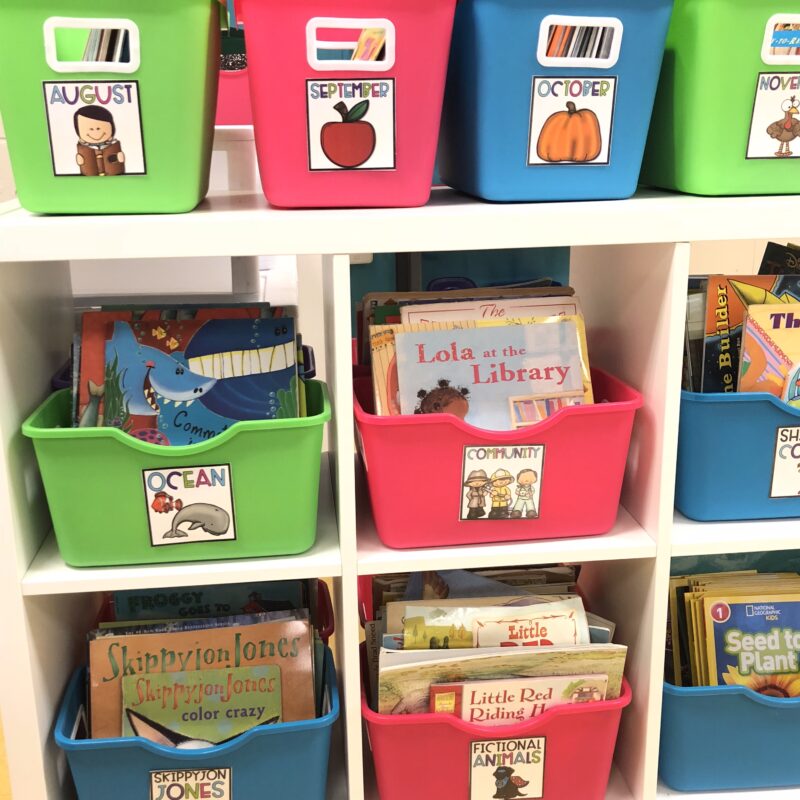
At the beginning of the year, I had my kindergarten classroom library in the center of the room. The low bins made it feel accessible, but I eventually moved it because I couldn’t see students on the other side. That was a great reminder of why I test out every seating and standing position before finalizing furniture placement. If you have the space, it also works well against a wall.
Create personalized book bins for each student
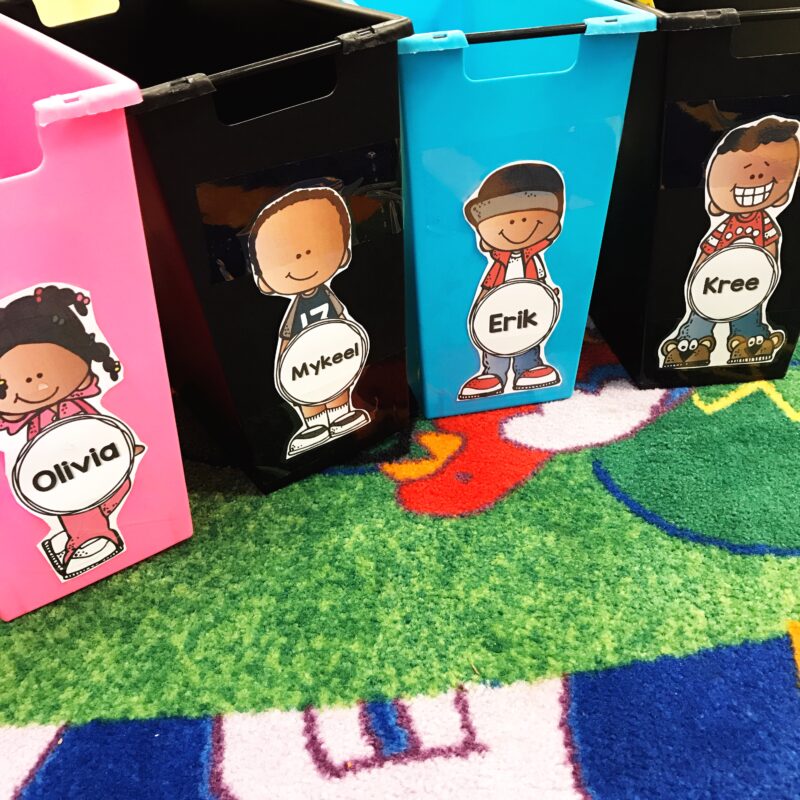
I use bins from Dollar Tree and Dollar General that are sturdy and affordable. I organize by theme, and students get to shop for books to fill their personal book bins. Each book bin has the student’s name and clipart photo. This process helps with classroom routines and keeps our library clean and organized.
Create word rings for writing support
One of my best tips for classroom setup is adding movable word rings. I hang them on command hooks around the room. Each ring includes themed vocabulary, seasonal words, or friends’ names. When students are writing and need help, they can grab a ring, take it to their spot, and return it when they’re done. It’s a great way to support writing without constant interruptions.
Set up a writing supplies station
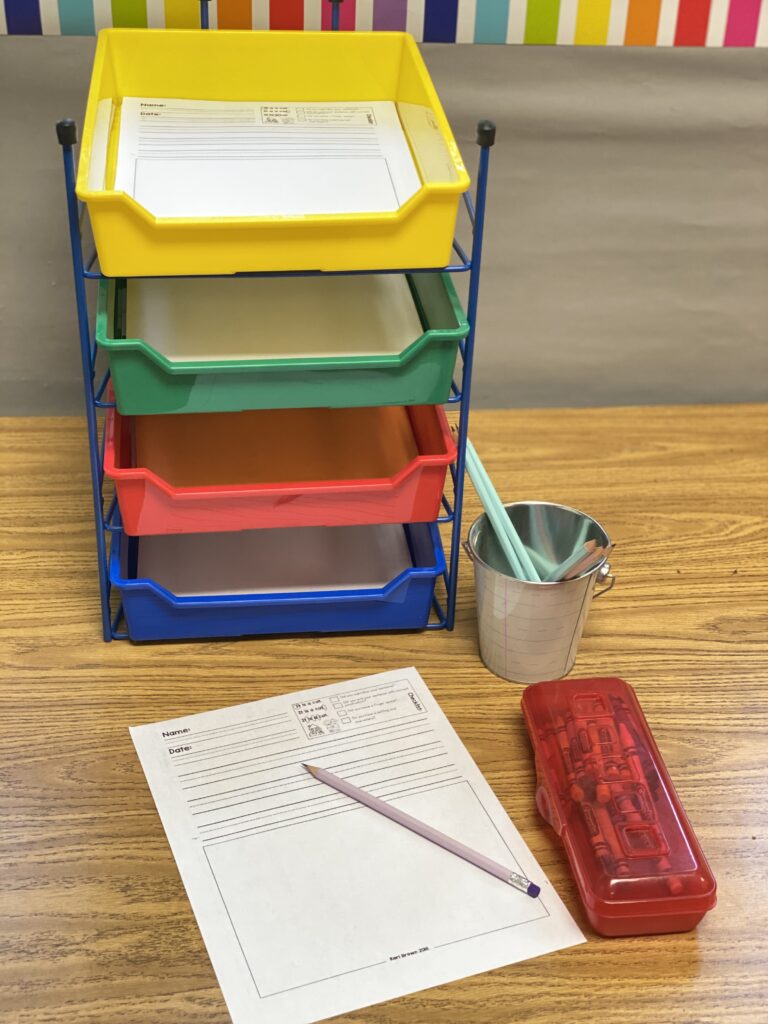
Later in the year, I add in more to a writing area for my students. They can write anywhere in the room, but I add in a paper tray with different paper. They learn how to choose which paper best fits their needs and can choose what they want. Having a space for this, helps them quickly get what they need.
Include flexible seating options
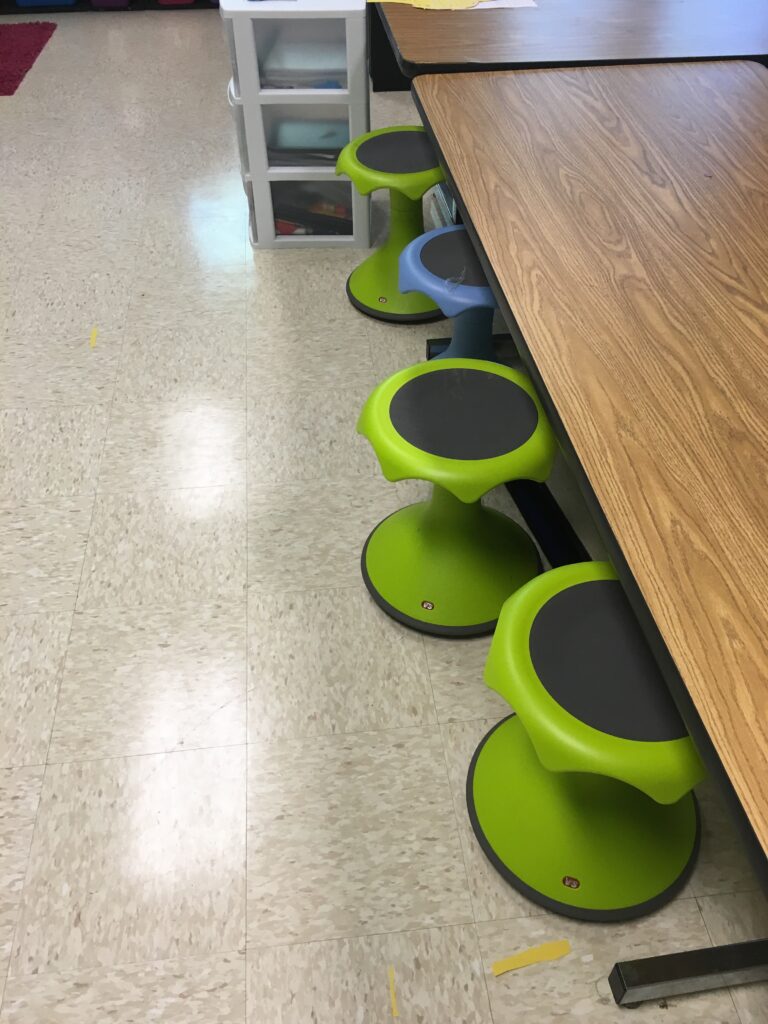
My classroom seating arrangements change based on student needs, but I always include flexible seating options: pillows, rugs, Hokki stools, and wobble chairs. Students get to choose the spot that helps them focus best. At the beginning of the year, we learn how to use each type of seating.
Flexible seating is an excellent opportunity to build social skills and give students ownership of their learning environment. You don’t need to buy brand-new classroom furniture. Yard sales, Facebook Marketplace, and donations can stretch your budget further.
Check out Best Flexible Seating Options for Today’s Classroom.
Place small rugs around the classroom for centers
Centers are a huge part of our day, so I put a lot of thought into where students will work. They can take center materials anywhere in the room, and I’ve placed small rugs around the classroom to give small groups dedicated spots to work. These rugs stay out all year.
Organize your center materials
Along one of the classroom walls, I keep two IKEA Trofast shelves. One is for math centers, and one is for word work games. These are sturdy, easy to access, and simple for students to clean up. When I’m planning a new center, I also consider what materials will be needed. If I want to include a writing table, I ensure extra paper, pencils, and student folders are nearby.
Choose classroom theme decor that serves a purpose
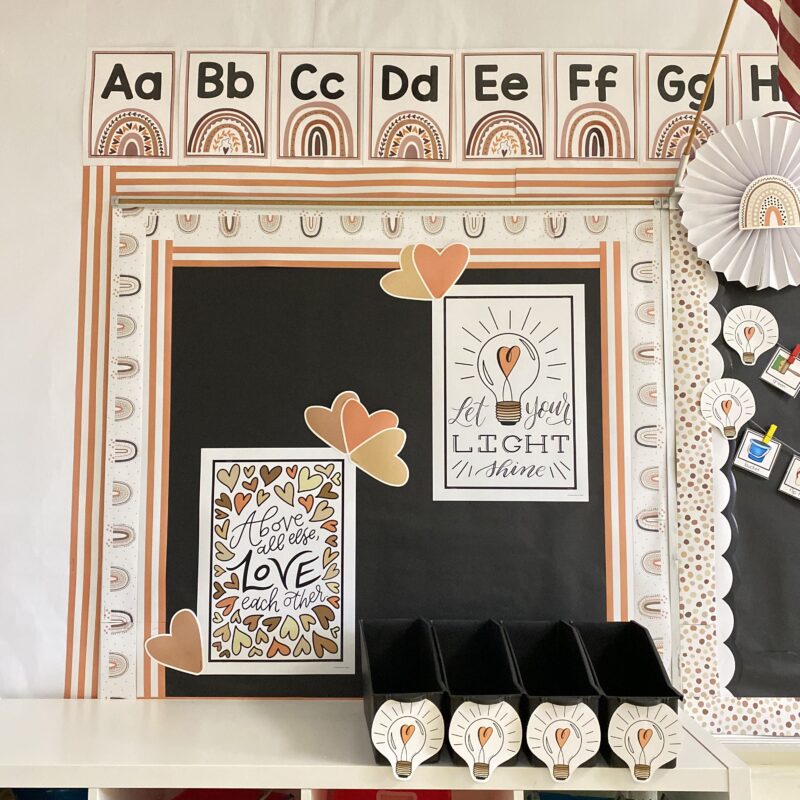
One year, I used a Schoolgirl Style rainbow theme with warm brown tones. Another year, I stuck with gray walls and bright pops of color. Either way, I keep it simple. I use poster sets to spell out large words like “Kindergarten” across blank spaces to add impact without clutter. Your classroom theme should complement your teaching style, not compete with it.
Need ideas? Here’s a huge list of classroom themes.
Declutter often
If you’re in a new classroom or short on storage space, the best tip I can give you is to declutter often. I store seasonal items in a closet, and anything oversized stays at home until I need it. Making space for your current students matters more than keeping everything you’ve ever used.
Let your space do the work for you
Setting up a kindergarten classroom takes time, planning, and some flexibility. Focus on building a classroom space that supports student learning, independence, and your teaching goals. It might take a little trial and error, but your classroom setup should work just as hard as you do.
View the original article and our Inspiration here

